
Ready to get certified?
Free CDCES Coach App

Subscribe
eNewsletter
Download
Free Med Pocket Cards
Rationale of the Week | Metformin and Cancer
For last week’s practice question, we quizzed participants on the interaction of Metformin with cancer. 66% of respondents chose the best answer. We want to clarify and share this important information, so you can pass it on to people living with diabetes and your colleagues, plus prepare for exam success!
Before we start though, if you don’t want any spoilers and haven’t tried the question yet, you can answer it below: Answer Question

Question: JR is taking Metformin 1000mg BID but is worried about getting cancer and is thinking about stopping the metformin.
Which of the following is an accurate statement regarding diabetes, metformin and cancer?
Answer Choices:
- There is research suggesting that metformin may be associated with a decreased risk of certain cancers.
- Metformin is associated with B12 deficiency and anemia, so it is best to hold metformin for now.
- There is no additional benefit from metformin, since people with diabetes have a slightly lower risk of liver and uterine cancers.
- Metformin does not increase risk of cancer, but it can negatively impact renal function.
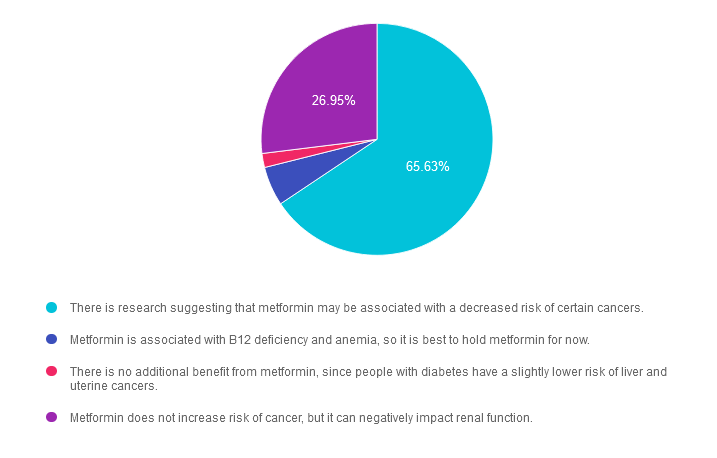
Getting to the Best Answer
Answer 1 is correct. 65.63% chose this answer. “There is research suggesting that metformin may be associated with a decreased risk of certain cancers.” Yes, this is the best answer. According to the ADA Standards, there is ongoing research on metformin’s potential role for decreasing and treating certain cancers due to it’s anti-inflammatory action at a cellular level. Metformin is the most common diabetes medication in use worldwide for good reason. It is affordable and effective. In addition to lowering blood glucose and LDL cholesterol, metformin increases gut microbiota diversity and has an excellent safety profile. See our Meds PocketCard for more info.
Answer 2 is incorrect. 5.47% of you chose this answer. “Metformin is associated with B12 deficiency and anemia, so it is best to hold metformin for now.” While it is true that some individuals experience B12 deficiency with metformin, the benefits of metformin outweigh the potential impact on vitamin B12 deficiency. It is important to evaluate anemia and nerve pain in people on metformin and provide B12 replacement therapy if indicated. See our Meds PocketCard for more info.
Answer 3 is incorrect. About 1.95% of respondents chose this. “There is no additional benefit from metformin, since people with diabetes have a slightly lower risk of liver and uterine cancers.” People with diabetes have increased risk of breast, liver and pancreatic cancers. Encouraging healthy lifestyle along with regular cancer screenings is an integral part of providing diabetes care. See our Meds PocketCard for more info.
Finally, Answer 4 is incorrect. 26.95% chose this answer. “Metformin does not increase risk of cancer, but it can negatively impact renal function.” This answer is FALSE. Many people with diabetes have recently shared with me that they are worried that metformin is “bad” for them and causes kidney damage. There is no data to support this and the opposite is actually true. Since metformin lowers A1C by 1-2% points, it protects the kidneys and blood vessels. Metformin is mostly cleared by the kidneys, so the GFR needs to be at least 30 mL/min to safely take metformin. However, metformin has no negative impact on kidney function and is considered a very safe and beneficial diabetes medication by the scientific and medical community, See our Meds PocketCard for more info.
We hope you appreciate this week’s rationale! Thank you so much for taking the time to answer our Question of the Week and participate in this fun learning activity!

|
|
We love her wicked sense of humor, organizational skills, and extensive knowledge, all packaged together with her big-hearted humanity. Bryanna is also the proud mama of Biscuit and Muffin, who she often features as the feline stars in her “Cat Bakery.” Thank you, Bryanna, for your generosity and for leading our team with your expertise, humanity, and kindness. |

Sign up for Diabetes Blog Bytes – we post weekly Blog Bytes that are informative and FREE! Every week we post one exam practice Question of the Week and Rationale of the Week. Sign up below!
Recent Blog Bytes
Accreditation: Diabetes Education Services is an approved provider by the California Board of Registered Nursing, Provider 12640, and our CPEU courses have received Prior Approval* from the Commission of Dietetic Registration (CDR), Provider DI002. Since our CPEU courses received Prior approval* from the CDR, these CPEU courses satisfy the CE requirements for the CDCES /BC-ADM regardless of your profession!
The use of DES products does not guarantee the successful passage of the certification exam. CBDCE and ADCES do not endorse any preparatory or review materials for the CDCES or BC-ADM exams, except for those published by CBDCE & ADCES.
Rationale of the Week | JR Wants to Avoid Ingrown Toenails
For last week’s practice question, we quizzed participants on avoiding ingrown toenails. 61% of respondents chose the best answer. We want to clarify and share this important information, so you can pass it on to people living with diabetes and your colleagues, plus prepare for exam success!
Before we start though, if you don’t want any spoilers and haven’t tried the question yet, you can answer it below: Answer Question

Question: JR lives with type 2 diabetes and works 10-11 hours a day driving a tractor for a local farm. It is difficult for JR to make medical appointments since their employer has very strict attendance guidelines. JR has ingrown toenails in the big toes, that cause a great deal of pain. Since they didn’t have time to come in for care, JR cut off half of their toenails on both feet to prevent an ingrown nail. As you inspect JR’s feet, you see that their big toes are swollen and red. You ask the provider to evaluate JR’s feet because you are worried. After the provider evaluates JR’s feet, they turn to JR and say, “Diabetics should never cut their toenails like this. It causes infection”.
What is this an example of?
Answer Choices:
- Effective cultural humility coupled with compliance model.
- Avoidance of the adherence model and promotion of transtheoretical approach.
- Adult learning theory disruption coupled with interpersonal shaming.
- Unawareness of language and the impact of social determinants of health.

Getting to the Best Answer
Answer 1 is incorrect. 5.94% chose this answer. “Effective cultural humility coupled with compliance model.” The provider’s response was not culturally humble or thoughtful of JR’s economic circumstance or social determinants of health. This provider could benefit from coaching on how to use a strength based approach coupled with addressing individuals with respect and person-centered language. Watch our “Language Matters” FREE Webinar for helpful information.
Answer 2 is incorrect. 7.53% of you chose this answer. “Avoidance of the adherence model and promotion of transtheoretical approach.” The provider’s response was based on the old fashioned compliance model. The provider was not thoughtful of JR’s readiness for change or their circumstance. This provider could benefit from coaching on how to use a strength based approach coupled with addressing individuals with respect and person-centered language. Watch our “Language Matters” FREE Webinar for helpful information.
Answer 3 is incorrect. About 26.03% of respondents chose this. “Adult learning theory disruption coupled with interpersonal shaming.” The provider’s response did not consider the expertise of the individual or adult learning theory, so they didn’t disrupt adult learning theory because they never initiated it. The provider did speak to JR using shame based language and the word “should”. Watch our “Language Matters” FREE Webinar for helpful information.
Finally, Answer 4 is correct. 60.50% chose this answer. “Unawareness of language and the impact of social determinants of health.” YES, this is the best answer This provider could benefit from coaching on how to use a strength based approach coupled with addressing individuals with respect and person-centered language. Watch our “Language Matters” FREE Webinar for helpful information.
We hope you appreciate this week’s rationale! Thank you so much for taking the time to answer our Question of the Week and participate in this fun learning activity!
Want to learn more about this question?
Join us Live in Beautiful San Diego for our
Annual DiabetesEd Training Conference
October 9th-11th, 2024

Join Coach Beverly and Team for two and a half days of knowledge-sharing, fun, networking, games with prizes, and “aha” moments in beautiful San Diego on October 9-11, 2024.
You don’t want to miss this one-of-a-kind learning opportunity. Get away from all those daily responsibilities and immerse yourself in a fun and intensive conference with plenty of networking opportunities.
Attendees will leave this conference with new tools and a more complete understanding of the latest advances in diabetes care, from medications to technology to Medical Nutrition Therapy!
Each day, we provide a healthy breakfast, including fresh coffee, to kick off your morning. Our instructors co-teach the content to keep things fresh and lively. Plus, we play DiaBingo to reinforce key content. In addition, we provide plenty of movement breaks led by volunteers from the audience. Did we mention delicious lunches and a conference meeting space just minutes from San Diego Bay?
Friend Discount: 3 or more only $559-$799 (based on registration package) per person. Email us at [email protected] with the name and email of each registrant to get the discount!

Time: The course is Wednesday through Friday. Join us for breakfast at 7:00 a.m. each day. The class begins at 8:00 a.m. and ends at 5:00 p.m. on Wednesday and Thursday and at 3:00 p.m. on Friday.
- 3 Days: of critical information delivered by passionate speakers in an engaging and fun format!
- 18+ CEs: earned at the Live Seminar (RDs earn 18.75 CEs while Nurses & CA Pharmacists earn 22.75 CEs)
- 10 Bonus Online Courses, Earn 10+ CEs: As a course attendee, you automatically receive a bonus online course bundle of 13 online courses valued at over $179. Coach Beverly carefully chose each of these courses based on student feedback on which content best helped them succeed at the certification exams and in their clinical practice. You will be given instructions after you purchase the course on how to enroll in our Online University and get started!
- Healthy breakfast all days, gourmet lunch both days and refreshments.
- E-version of the syllabus
Sign up for Diabetes Blog Bytes – we post weekly Blog Bytes that are informative and FREE! Every week we post one exam practice Question of the Week and Rationale of the Week. Sign up below!
Recent Blog Bytes
Accreditation: Diabetes Education Services is an approved provider by the California Board of Registered Nursing, Provider 12640, and our CPEU courses have received Prior Approval* from the Commission of Dietetic Registration (CDR), Provider DI002. Since our CPEU courses received Prior approval* from the CDR, these CPEU courses satisfy the CE requirements for the CDCES /BC-ADM regardless of your profession!
The use of DES products does not guarantee the successful passage of the certification exam. CBDCE and ADCES do not endorse any preparatory or review materials for the CDCES or BC-ADM exams, except for those published by CBDCE & ADCES.
Rationale of the Week | Most important action in case of fire?
For last week’s practice question, we quizzed participants on most important action in case of fire. Most of our respondents chose the best answer. GREAT JOB. We want use this rationale to share important resources on Disaster Preparedness. We encourage you to pass this info on to people living with diabetes and your colleagues. Plus this info will prepare you for exam success!
Before we start though, if you don’t want any spoilers and haven’t tried the question yet, you can answer it below: Answer Question

Question:
JR lives with type 1 diabetes and uses an insulin pump and sensor. They live in an area that is fire prone and JR asks you about how they should prepare for an emergency if evacuation is required.
What action is most important?
Answer Choices:
- Make sure they have their health history documented and stored in a watertight bag.
- Prepare an emergency kit that includes at least one week’s worth of diabetes supplies.
- Keep a fire extinguisher within easy reach and know the exit routes.
- Reach out to emergency responders ahead of time to let them know that JR has type 1 diabetes.

Getting to the Best Answer
Answer 1 is incorrect. 2.38% chose this answer. “Make sure they have their health history documented and stored in a watertight bag.” Having easy access to your health history, including emergency contacts, provider, list of current medications etc., is always a sound idea. Encourage people to have a copy on their electronic devices and a printed copy if possible. However, in this question, it is not the MOST important action. See Disaster Preparedness Resources & Printable Checklist.
Answer 2 is correct. 89.97% of you chose this answer. “Prepare an emergency kit that includes at least one week’s worth of diabetes supplies.” YES, GREAT JOB. This is the best answer. Having a pre-packed get away bag that has at least one week of diabetes supplies, plus snacks, water, clothes, battery back-up for electronic devices and other items as detailed here Disaster Preparedness Resources & Printable Checklist is a top priority for people with diabetes. Disaster can strike at any time and planning ahead can be life saving.
Answer 3 is incorrect. About 4.48% of respondents chose this. “Keep a fire extinguisher within easy reach and know the exit routes.” All people benefit from having a fire extinguisher in their home and making sure there is a clear exit path. However, this is not the most important action. See Disaster Preparedness Resources & Printable Checklist.
Finally, Answer 4 is incorrect. 3.17% chose this answer. “Reach out to emergency responders ahead of time to let them know that JR has type 1 diabetes.” It is important to sign-up for electronic and/or phone notifications of impending disasters to be alerted to emergencies. However, there is not a system in place to notify emergency responders ahead of time that someone has type 1 diabetes. For more info, see Disaster Preparedness Resources & Printable Checklist.
We hope you appreciate this week’s rationale! Thank you so much for taking the time to answer our Question of the Week and participate in this fun learning activity!
Resources for Disaster Preparedness
Want to learn more about this question?
Join us live on July 18th, for our
Type 2 Diabetes Intensive
Level 4 | Advanced Level & Specialty Topics

This course provides a detailed overview of the pathophysiology of type 2 diabetes, prevention strategies, & cardiovascular risk reduction. In addition, we highlight type 2 treatment approaches including nutrition, activity, oral & injectable medications plus screening & treatment guidelines for micro & macrovascular diseases. Through case studies & discussion, we highlight strategies to focus on a person-centered approach along with attention to psychosocial care for people living with diabetes.
Objectives:
- Discuss the current epidemiology of type 2 diabetes.
- Describe the classification, terminology & diagnostic criteria for diabetes.
- Identify the eight pathophysiologic defects associated with the ominous octet.
- Describe evidence and strategies to prevent type 2 diabetes.
- State strategies to implement a person-centered approach to those with diabetes.
- Discuss key aspects of type 2 diabetes management including education, therapeutic lifestyle changes, glucose, lipid, & hypertension management plus referrals.
- Understand the overarching principles of management of type 2 DM.
Learning Outcome:
Attendees will be able to articulate and integrate into practice the impact, goals, and management strategies for people living with type 2 diabetes.
Target Audience:
This course is a knowledge-based activity designed for individuals or groups of diabetes professionals, including RNs, RDs/RDNs, Pharmacists, Nurse Practitioners, Clinical Nurse Specialists, Physician Assistants, and other healthcare providers interested in staying up to date on current practices of care for people with prediabetes, diabetes, and other related conditions. The practice areas for RDs/RDNs for CDR reporting are healthcare, preventative care, wellness, and, lifestyle along with, education and research.
CDR Performance Indicators:
- 10.4.2
- 10.5.1
Instructor: Beverly Thomassian RN, MPH, CDCES, has been Board Certified in Advanced Diabetes Management for over 15 years. She is an Associate Clinical Professor at UCSF, a working educator, and a nationally recognized diabetes expert.
All hours earned count toward your CDCES Accreditation Information
Sign up for Diabetes Blog Bytes – we post weekly Blog Bytes that are informative and FREE! Every week we post one exam practice Question of the Week and Rationale of the Week. Sign up below!
Recent Blog Bytes
Accreditation: Diabetes Education Services is an approved provider by the California Board of Registered Nursing, Provider 12640, and our Level 4 | Type 2 Diabetes Intensive awards 2.0 CPEUs in accordance with the Commission on Dietetic Registration’s CPEU Prior Approval Program.
The use of DES products does not guarantee the successful passage of the certification exam. CBDCE and ADCES do not endorse any preparatory or review materials for the CDCES or BC-ADM exams, except for those published by CBDCE & ADCES.
Rationale of the Week | Primary Goals for the DPP?
For last week’s practice question, we quizzed participants on primary goals of the DPP. 62% of respondents chose the best answer. We want to clarify and share this important information, so you can pass it on to people living with diabetes and your colleagues, plus prepare for exam success!
Before we start though, if you don’t want any spoilers and haven’t tried the question yet, you can answer it below: Answer Question

Question: The Diabetes Prevention Program (DPP) primary lifestyle intervention goals include achieving and maintaining a minimum of 7% weight loss and 150 minutes of moderate-intensity physical activity per week.
What outcomes are expected from these intervention goals?
Answer Choices:
- DPP lifestyle intervention resulted in a 58% reduction of rate of diabetes over 3 years.
- Sustained interventions over 15 years reduced risk of progression to type 2 diabetes by 27%.
- Achieving 150 minutes of moderate-intensity activity per week without weight loss is adequate to reduce incidence of type 2 diabetes.
- All the above.
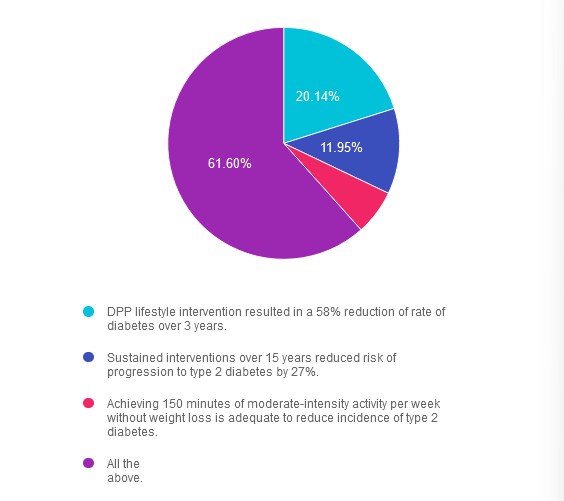
Getting to the Best Answer
Answer 1 is incorrect. 20.14% chose this answer. “DPP lifestyle intervention resulted in a 58% reduction of rate of diabetes over 3 years.” A is correct but is not the best answer. The initial DPP study included 1,079 participants who participated in lifestyle interventions and found a 58% reduction in the rate of diabetes.
Answer 2 is incorrect. 11.95% of you chose this answer. “Sustained interventions over 15 years reduced risk of progression to type 2 diabetes by 27%.” B is correct but not the best answer. The 15-year follow-up study validated that diabetes incidence was reduced by 27% for lifestyle intervention participants.
Answer 3 is incorrect. About 6.31% of respondents chose this. “Achieving 150 minutes of moderate-intensity activity per week without weight loss is adequate to reduce incidence of type 2 diabetes.” Response C is correct but not the best answer. Weight loss is an important factor in reducing the risk of diabetes progression; however, the DPP study found that even without achieving weight loss goals, the incidence of type 2 diabetes was reduced by 44% if at least 150 minutes of physical activity per week was achieved.
Finally, Answer 4 is correct. 61.60% chose this answer. “All of the above.” Answer D is correct and is the best answer.
References:
- American Diabetes Association Professional Practice Committee; 3. Prevention or Delay of Diabetes and Associated Comorbidities: Standards of Care in Diabetes—2024. Diabetes Care1 January 2024; 47 (Supplement_1): S43–S51. https://doi.org/10.2337/dc24-S003
National Diabetes Prevention Program Coverage Toolkit. Downloaded on July 19th, 2024 from https://coveragetoolkit.org.
We hope you appreciate this week’s rationale! Thank you so much for taking the time to answer our Question of the Week and participate in this fun learning activity!
Sign up for Diabetes Blog Bytes – we post weekly Blog Bytes that are informative and FREE! Every week we post one exam practice Question of the Week and Rationale of the Week. Sign up below!
Recent Blog Bytes
Accreditation: Diabetes Education Services is an approved provider by the California Board of Registered Nursing, Provider 12640, and our CPEU courses have received Prior Approval* from the Commission of Dietetic Registration (CDR), Provider DI002. Since our CPEU courses received Prior approval* from the CDR, these CPEU courses satisfy the CE requirements for the CDCES /BC-ADM regardless of your profession!
The use of DES products does not guarantee the successful passage of the certification exam. CBDCE and ADCES do not endorse any preparatory or review materials for the CDCES or BC-ADM exams, except for those published by CBDCE & ADCES.
Rationale of the Week | Why did 16 year old stop taking meds?
For last week’s practice question, we quizzed participants on Why a 16 year old stopped taking their medication. 88% of respondents chose the best answer. We want to clarify and share this important information, so you can pass it on to people living with diabetes and your colleagues, plus prepare for exam success!
Before we start though, if you don’t want any spoilers and haven’t tried the question yet, you can answer it below: Answer Question

Question: A 16 year old tells you they stopped taking their diabetes medications. “It doesn’t seem to matter whether or not I take them”.
What is the best response?
Answer Choices:
- Acknowledge their honesty and ask them to discuss with their provider.
- Gently remind them that stopping their meds is dangerous.
- Ask them if they are experiencing trauma at home.
- Explore possible reasons for this action.
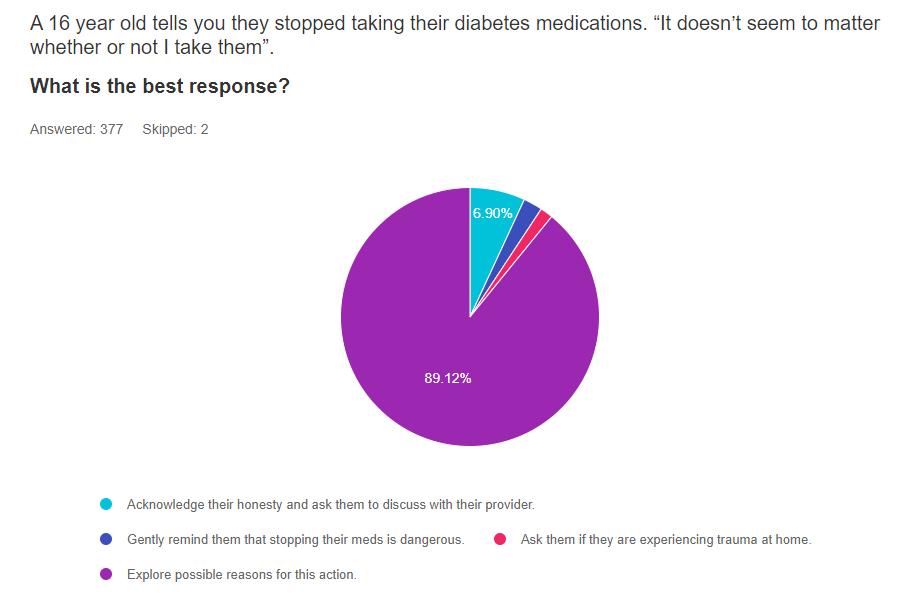
Getting to the Best Answer
Answer 1 is incorrect. 6.9% chose this answer. “Acknowledge their honesty and ask them to discuss with their provider.” The first part of this answer is correct. We want to acknowledge their honesty and provide a non-judgmental environment. However, we want to explore their feelings further as part of this current appointment instead of stopping the conversation and deferring to the provider. For more information on this topic, you are invited to our Language and Diabetes Webinar. We hope you can join us. See below for more info!
Answer 2 is incorrect.2.39% of you chose this answer. “Gently remind them that stopping their meds is dangerous.” This person is experiencing diabetes distress, so we want to acknowledge their feelings and explore strategies to decease distress. When people with diabetes are experiencing distress, approaching the situation with curiosity and non-judgment is always the best approach. For more information on this topic, you are invited to our Language and Diabetes Webinar. We hope you can join us. See below for more info!
Answer 3 is incorrect. About 1.59% of respondents chose this. “Ask them if they are experiencing trauma at home.” While trauma at home can cause significant distress, this individual has stopped taking their diabetes medications since they are not sure if they actually work. Asking about trauma at home doesn’t match the concern they are verbalizing at this moment. When people with diabetes are experiencing distress, approaching the situation with curiosity and non-judgment is always the best approach. For more information on this topic, you are invited to our Language and Diabetes Webinar. We hope you can join us. See below for more info!
Finally, Answer 4 is correct. 89% chose this answer. “Explore possible reasons for this action.” YES, this is the best answer and almost 90% of respondents chose this answer. GREAT JOB. When people with diabetes are experiencing distress, approaching the situation with curiosity and non-judgment is always the best approach. For more information on this topic, you are invited to our Language and Diabetes Webinar. We hope you can join us. See below for more info!
We hope you appreciate this week’s rationale! Thank you so much for taking the time to answer our Question of the Week and participate in this fun learning activity!
Want to learn more about this question?
Join us live on July 11th at 11:30 am PST for our
Language and Diabetes FREE Webinar
What we say matters.
As educators, advocates, spouses, friends, and providers, our use of language can deeply affect the self-view of people living with diabetes every day.
Intentional communication is a powerful tool that can uncover trauma, identify barriers, and move both the provider and person with diabetes toward a greater understanding of the issues involved.
The language used in the health care setting is immensely important in determining trust, mutual respect, and meaningful long-term relationships.
Topics covered include:
- Learn phrases, words, and approaches that can be left behind.
- Describe diabetes language that is respectful, inclusive, person-centered, and imparts hope.
- Discuss how to evaluate for ACE and provide trauma-informed care
- Practice communicating about diabetes using phrases free from judgment with a focus on a strength-based approach
This webinar is free and you can view it at any time, on any device. To earn CEs, you can purchase this course at our online university store.
Coach Beverly Thomassian, RN, MPH, BC-ADM, CDCES
Author, Nurse, Educator, Clinician, and Innovator, Beverly has specialized in diabetes management for over twenty years. As president and founder of Diabetes Educational Services, Beverly is dedicated to optimizing diabetes care and improving the lives of those with diabetes.
All hours earned count toward your CDCES Accreditation Information
Sign up for Diabetes Blog Bytes – we post weekly Blog Bytes that are informative and FREE! Every week we post one exam practice Question of the Week and Rationale of the Week. Sign up below!
Recent Blog Bytes
The use of DES products does not guarantee the successful passage of the certification exam. CBDCE and ADCES do not endorse any preparatory or review materials for the CDCES or BC-ADM exams, except for those published by CBDCE & ADCES.
Rationale of the Week | What does Medicare Cover?
For last week’s practice question, we quizzed participants on what Medicare will cover. 54% of respondents chose the best answer. We want to clarify and share this important information, so you can pass it on to people living with diabetes and your colleagues, plus prepare for exam success!
Before we start though, if you don’t want any spoilers and haven’t tried the question yet, you can answer it below: Answer Question

Question: KT just turned 65 and asks you about Medicare Insurance Coverage for Diabetes.
Which of the following is accurate regarding Medicare Coverage for people living with diabetes?
Answer Choices:
- Medicare Part D covers Diabetes Self-Management Education
- Medicare Part A covers Diabetes Prevention Programs.
- Medicare Part B covers durable medical equipment and diabetes medications.
- Medicare Part A covers hospitalization.
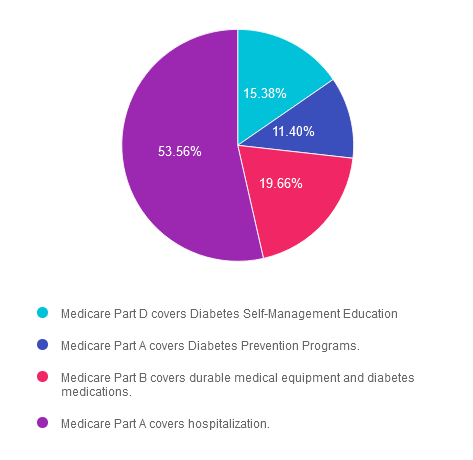
Getting to the Best Answer
Answer 1 is incorrect. 15.38% chose this answer. “Medicare Part D covers Diabetes Self-Management Education.” Actually, medicare Part D helps cover the cost of prescription drugs. Part D is optional and only provided through private insurance companies approved by the federal government. However, Part D is offered to everyone who qualifies for Medicare. Costs and coverage may vary from plan to plan
Answer 2 is incorrect. 11.4% of you chose this answer. “Medicare Part A covers Diabetes Prevention Programs.” Actually, medicare part A covers inpatient hospital stays, care in a skilled nursing facility, hospice care, and some home health care.
Answer 3 is incorrect. About 19.66% of respondents chose this. “Medicare Part B covers durable medical equipment and diabetes medications.” Part B doesn’t help cover diabetes medications, but Part B does cover:
- Services from doctors and other health care providers
- Diabetes Self-Management Education
- Outpatient care, Home health care
- Durable medical equipment (like meters, CGMs, wheelchairs, walkers, hospital beds, and other equipment)
- Many preventive services (like screenings, shots or vaccines, and yearly “Wellness” visits)
Finally, Answer 4 is correct. 53.56% chose this answer. “Medicare Part A covers hospitalization.” YES, GREAT JOB. This is the best answer.
Medicare Part A covers:
- Inpatient care in a hospital
- Skilled nursing facility care
- Nursing home care (inpatient care in a skilled nursing facility that’s not custodial or long-term care)
- Hospice care
- Home health care
We hope you appreciate this week’s rationale! Thank you so much for taking the time to answer our Question of the Week and participate in this fun learning activity!
Sign up for Diabetes Blog Bytes – we post weekly Blog Bytes that are informative and FREE! Every week we post one exam practice Question of the Week and Rationale of the Week. Sign up below!
Recent Blog Bytes
Accreditation: Diabetes Education Services is an approved provider by the California Board of Registered Nursing, Provider 12640, and our Level 2 | Setting up a Successful DSME Program awards 1.5 CPEUs in accordance with the Commission on Dietetic Registration’s CPEU Prior Approval Program.
The use of DES products does not guarantee the successful passage of the certification exam. CBDCE and ADCES do not endorse any preparatory or review materials for the CDCES or BC-ADM exams, except for those published by CBDCE & ADCES.
Rationale of the Week | Inpatient didn’t get bolus insulin before lunch. What is best action?
For last week’s practice question, we quizzed participants on missing bolus insulin before lunch, how should you follow up? 66% of respondents chose the best answer. We want to clarify and share this important information, so you can pass it on to people living with diabetes and your colleagues, plus prepare for exam success!
Before we start though, if you don’t want any spoilers and haven’t tried the question yet, you can answer it below: Answer Question

Question: RT is in the hospital with pneumonia. Based on pre lunch glucose check, RT needs 3 units bolus insulin for lunch. RT’s blood glucose before lunch (20 minutes ago) was 173. You walk in room and RT is almost done with lunch.
What is best action?
Answer Choices:
- Give the 3 units of bolus insulin now.
- Hold the bolus insulin since RT is almost done.
- Recheck the glucose now and adjust insulin dose accordingly.
- Call MD for further instructions.
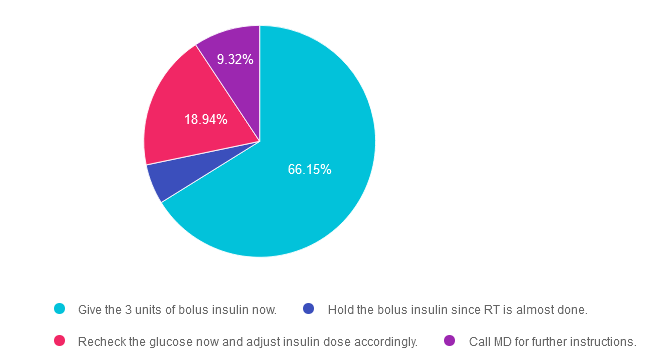
Getting to the Best Answer
Answer 1 is correct. 66.15% chose this answer. “Give the 3 units of bolus insulin now.” YES, this is the BEST answer. Since RT just checked their blood glucose 20 minutes ago, even though they have consumed most of their meal, it is best to give the bolus insulin now so the insulin can help blunt the post prandial increase. It also provides a great teaching moment to encourage individuals to give insulin before eating, to allow the insulin to start working to match the post meal increase from food.
Answer 2 is incorrect. 5.59% of you chose this answer. “Hold the bolus insulin since RT is almost done.” If we hold the bolus insulin, RT’s blood glucose level will go above target since there would be no insulin available to store the incoming carbohydrates in muscle and liver cells as glycogen.
Answer 3 is incorrect. About 18.94% of respondents chose this. “Recheck the glucose now and adjust insulin dose accordingly.” Unfortunately, this is not a good time to determine insulin needs based on glucose. Since RT is eating, the blood sugars are rising and we might end up giving too much insulin based on this temporary increase. It is best to determine insulin dose on premeal glucose and anticipated carb consumption.
Finally, Answer 4 is incorrect. 9.32% chose this answer. “Call MD for further instructions.” No need to call for instructions in this situation. If a person with diabetes experienced this situation at home, they would simply give their insulin mid-meal. In this situation, it won’t cause any harm to give the recommended dose now. It also provides a great teaching moment to encourage individuals to give insulin before eating, to allow the insulin to start working to match the post meal increase from food.
We hope you appreciate this week’s rationale! Thank you so much for taking the time to answer our Question of the Week and participate in this fun learning activity!
Want to learn more about this question?
Join us live on [Air Date] for our
Hospitals & Hyperglycemia
Level 2 Standards of Care Intensive

Research demonstrates the importance of glucose control during hospitalization to improve outcomes not only in the inpatient setting but after discharge. This course reviews the evidence that supports inpatient glucose control & outlines practical strategies to achieve targets in the inpatient setting. We incorporate the latest American Diabetes Association’s (ADA) Standards of Medical Care in Diabetes & provide links to resources & inpatient management templates.
Objectives:
- Describe the impact of hyperglycemia in the hospital setting.
- Discuss the importance of inpatient glucose control.
- List three strategies to get glucose to the goal in the hospital setting.
Learning Outcome:
The diabetes care team will gain insights and knowledge of special considerations, individualized goals, and standards for inpatients with diabetes that they can include in their practice.
Target Audience:
This course is a knowledge-based activity designed for individuals or groups of diabetes professionals, including RNs, RDs/RDNs, Pharmacists, Nurse Practitioners, Clinical Nurse Specialists, Physician Assistants, and other healthcare providers interested in staying up to date on current practices of care for people with prediabetes, diabetes, and other related conditions. The practice areas for RDs/RDNs for CDR reporting are healthcare, preventative care, wellness, and, lifestyle along with, education and research.
CDR Performance Indicators:
- 9.6.7
- 9.6.8
- 10.3.1
Instructor: Beverly Thomassian RN, MPH, CDCES, BC-ADM is a working diabetes specialist and a nationally recognized diabetes expert.
Sign up for Diabetes Blog Bytes – we post weekly Blog Bytes that are informative and FREE! Every week we post one exam practice Question of the Week and Rationale of the Week. Sign up below!
Recent Blog Bytes
Accreditation: Diabetes Education Services is an approved provider by the California Board of Registered Nursing, Provider 12640, and our CPEU courses have received Prior Approval* from the Commission of Dietetic Registration (CDR), Provider DI002. Since our CPEU courses received Prior approval* from the CDR, these CPEU courses satisfy the CE requirements for the CDCES /BC-ADM regardless of your profession!
The use of DES products does not guarantee the successful passage of the certification exam. CBDCE and ADCES do not endorse any preparatory or review materials for the CDCES or BC-ADM exams, except for those published by CBDCE & ADCES.
Rationale of the Week | ADA Standards for Gestational Diabetes
For last week’s practice question, we quizzed participants on ADA standards for gestational diabetes. 43% of respondents chose the best answer. We want to clarify and share this important information, so you can pass it on to people living with diabetes and your colleagues, plus prepare for exam success!
Before we start though, if you don’t want any spoilers and haven’t tried the question yet, you can answer it below: Answer Question

Question: LS has type 1 diabetes and is here for the first visit after confirmation of pregnancy. LS has been using non-adjunctive continuous glucose monitoring (CGM) along with insulin pump therapy to manage diabetes. Previous visits have focused on preconception counseling and last A1c was 6.4%.
According to the 2024 ADA Standards of Care, what do we recommend regarding glucose monitoring during pregnancy?
Answer Choices:
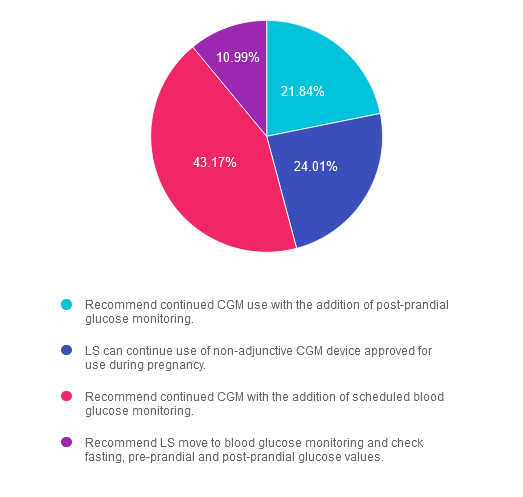
Getting to the Best Answer
Answer 1 is incorrect. 21.84% chose this answer. “Recommend continued CGM use with the addition of post-prandial glucose monitoring.” The 2024 ADA Standards of Care do recommend CGM use for individuals with type 1 diabetes during pregnancy but simply monitoring post-prandial glucose is insufficient. Keep reading below.
Answer 2 is incorrect. 24.01% of you chose this answer. “LS can continue use of non-adjunctive CGM device approved for use during pregnancy.” We can continue use of CGM devices during pregnancy, but blood glucose monitoring is recommended in addition to CGM.
Answer 3 is correct. About 43.17% of respondents chose this. GREAT JOB! “Recommend continued CGM with the addition of scheduled blood glucose monitoring.” The 2024 Standards of Care recommends CGM for individuals with type 1 diabetes during pregnancy but also recommends that it not replace pre-prandial and post-prandial blood glucose monitoring. Fasting, pre-prandial and post-prandial blood glucose monitoring is recommended for individuals with diabetes in pregnancy.
Finally, Answer 4 is incorrect. 10.99% chose this answer. “Recommend LS move to blood glucose monitoring and check fasting, pre-prandial and post-prandial glucose values.” We will recommend LS add blood glucose monitoring, but LS does not need to transition off CGM therapy.
Reference:
American Diabetes Association Professional Practice Committee; 15. Management of Diabetes in Pregnancy: Standards of Care in Diabetes—2024. Diabetes Care 1 January 2024; 47 (Supplement_1): S282–S294. https://doi.org/10.2337/dc24-S015
We hope you appreciate this week’s rationale! Thank you so much for taking the time to answer our Question of the Week and participate in this fun learning activity!
Want to learn more about this question?
Now Recorded & Ready to Watch
Pregnancy & Diabetes
Level 2 Standards of Care Intensive

Pregnancy with diabetes is confronted with a variety of issues that require special attention, education, & understanding. This course reviews those special needs while focusing on Gestational Diabetes & Pre-Existing Diabetes. Included are the most recent diagnostic criteria, management goals, & prevention of complications during pregnancy. This is a helpful review for Certification Exams & those who want more information on people who are pregnant & live with diabetes.
Objectives:
- List three issues that affect pregnancy with diabetes.
- Describe the unique attributes of pre-existing diabetes in pregnancy & gestational diabetes.
- State the diagnostic criteria & management goals for gestational diabetes.
- Potential short-term & long-term complications of fetal exposure to hypoglycemia.
- Prevention measures to keep mother & baby healthy.
Learning Outcome:
Participants will gain knowledge of special considerations, individualized goals, and standards for people experiencing diabetes during pregnancy to improve outcomes.
Target Audience:
This course is a knowledge-based activity designed for individuals or groups of diabetes professionals, including RNs, RDs/RDNs, Pharmacists, Nurse Practitioners, Clinical Nurse Specialists, Physician Assistants, and other healthcare providers interested in staying up to date on current practices of care for people with prediabetes, diabetes, and other related conditions. The practice areas for RDs/RDNs for CDR reporting are healthcare, preventative care, wellness, and, lifestyle along with, education and research.
CDR Performance Indicators:
- 9.6.7
- 9.6.8
- 10.3.1
Instructor: Beverly Thomassian RN, MPH, CDCES, BC-ADM is a working diabetes specialist and a nationally recognized diabetes expert.
Sign up for Diabetes Blog Bytes – we post weekly Blog Bytes that are informative and FREE! Every week we post one exam practice Question of the Week and Rationale of the Week. Sign up below!
Recent Blog Bytes
Accreditation: Diabetes Education Services is an approved provider by the California Board of Registered Nursing, Provider 12640, and our CPEU courses have received Prior Approval* from the Commission of Dietetic Registration (CDR), Provider DI002. Since our CPEU courses received Prior approval* from the CDR, these CPEU courses satisfy the CE requirements for the CDCES /BC-ADM regardless of your profession!
The use of DES products does not guarantee the successful passage of the certification exam. CBDCE and ADCES do not endorse any preparatory or review materials for the CDCES or BC-ADM exams, except for those published by CBDCE & ADCES.









